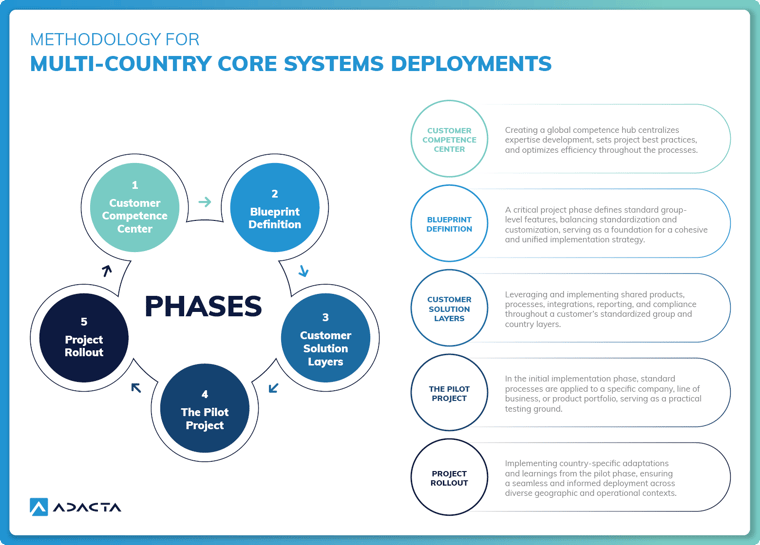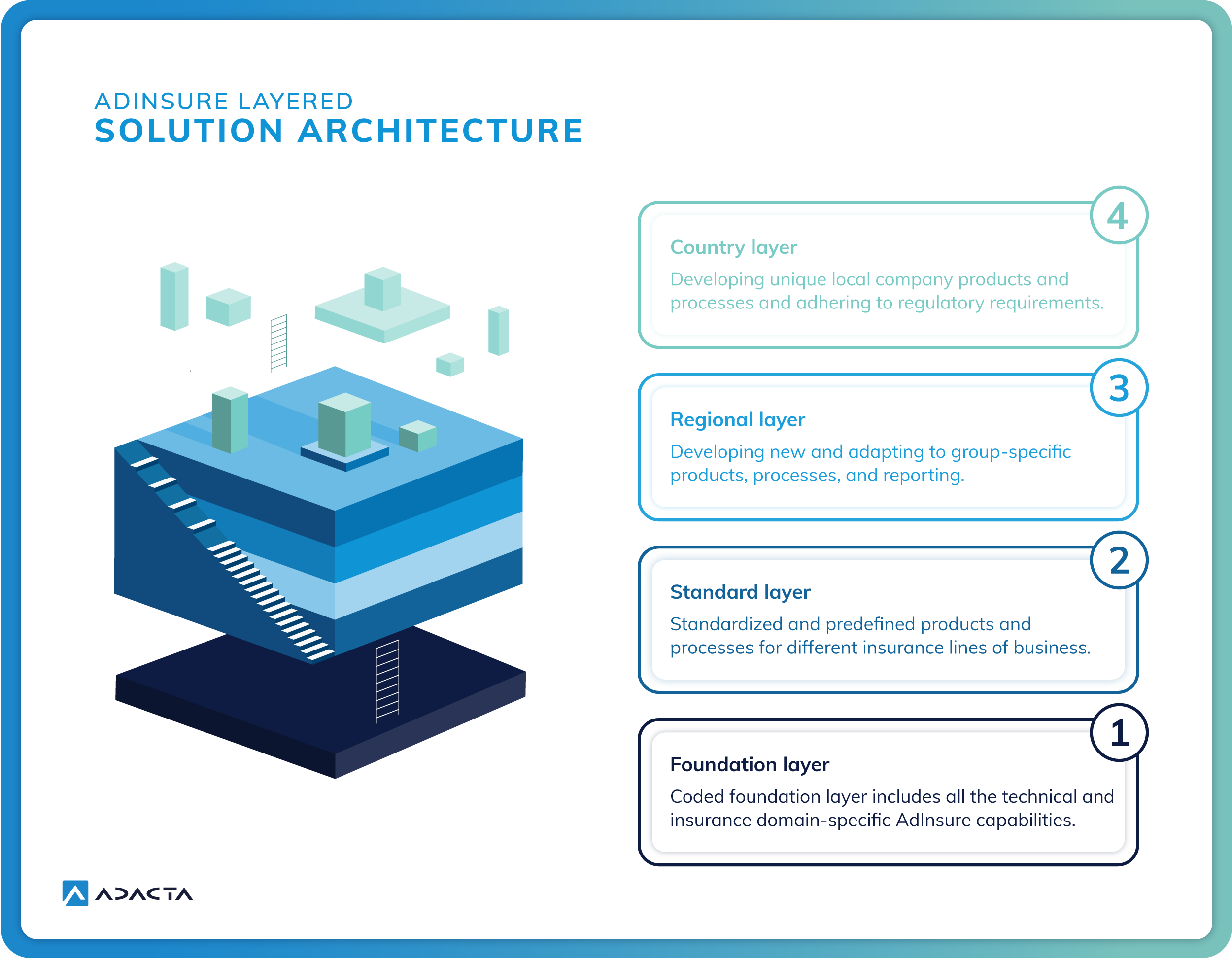
Blueprint for Success in Multi-country Core Insurance Software Deployments
Shifting from legacy systems to advanced technologies, such as next-generation core platforms, presents notable challenges for insurers. This transition demands deep commitment and collaboration among IT, operations, and business teams, aligning technical and strategic goals. The complexity escalates for international firms implementing this across different business lines and countries.
Nonetheless, this isn't entirely unexplored territory. Many insurance carriers have successfully undertaken this journey, gaining valuable insights. In this blog, we'll share our experiences and focus on the most effective practices for managing intricate, multi-country core insurance software deployments.
Table of content
- Navigating the Complexities of Multi-Country Insurance Core System Implementations
- Adacta's Methodology for overcoming multi-country roll-out complexities
- The Blueprint: defining common ground of different regions
- Finding the Right Mix of Standardization and Customization in Multi-Country operational initiatives
- Streamlining Insurance Processes, Compliance, and IT Architecture for Improved Standardization
- Enhancing Project Success through Specialized Governance and the AdInsure Group Competence Centre (AGCC)
- The Customer Solution Layers: Leveraging technology for Streamlined Insurance operations
- The cross-country Pilot project
- Navigating Country-Specific Implementation Projects through Staged Rollouts and Agile Sprints
- Country specific roll-outs
Navigating the Complexities of Multi-Country Insurance Core System Implementations
Deploying core insurance systems internationally is a multifaceted endeavor, distinct from single-country projects. Key challenges include:
- Regulatory Compliance: Navigating diverse insurance regulations and compliance across countries.
- Language, Currency, Tax: Addressing regional differences impacting user interfaces, billing, and accounting.
- Technology Integration and Standardization: Aligning technology across various systems and processes in different countries.
- Data Management and Security: Handling data with respect to different privacy laws.
- Customization vs. Standardization: Striking a balance between local market customization and global standardization.
- Change Management: Adapting people and processes to new technologies.
- Resource Allocation and Project Management: Efficiently managing resources like budget, personnel, and time.
- Market-Specific Features: Catering to unique requirements in each market.
- Scalability and Flexibility: Ensuring the technology can handle varying business volumes and adapt to future changes.
These challenges make balancing risk management, operational efficiency, and innovation potential a complex task.
Adacta's Methodology for overcoming multi-country roll-out complexities
At Adacta, our deep experience in core insurance software implementation for individual companies and groups is pivotal in guiding our strategies for complex, multi-national deployments.
Our approach focuses on reducing operational risks and includes IT and process consolidation, supported by stringent governance practices and effective methodology.
We have founded our distinct methodology on five principles:
- Blueprint Definition,
- Customer Competence Centre,
- Customer Solution Layers,
- The Pilot,
- The Rollout.
In adhering to our structured concepts and phases, we aim to refine the implementation process, minimize operational risk, and improve project efficiency. Central to our methodology is AdInsure, our technology known for its multi-layered and customizable architecture, which will be the focus of our next blog article.
The Blueprint: defining common ground of different regions
In cross-country software solution projects, a crucial step is to establish a common standard across countries. This involves defining group-level features that form the foundation for a unified and successful implementation strategy.
Standardization is an important aspect of the overall project Blueprint defined as a collaboration between Adacta’s Business Analyst, Consulting, and Architecture teams and key Customer Group business stakeholders; this phase involves:
- Defining standard Cross-Country product definitions and business processes,
- Adopting local to standard client processes,
- Defining standard cross-country infrastructure and integrations,
- Analyzing gaps between these processes and core platform standard features,
- Defining project and roll-out approach and timelines,
A crucial outcome of this phase is the technical blueprint, particularly the development of a Customer Group layer (see image) within the core systems-based solution.
Finding the Right Mix of Standardization and Customization in Multi-Country operational initiatives
Achieving standardization in cross-country insurance projects can be challenging, yet it's essential for success. The challenges include different ways of working, the size of organizations, and different maturity levels.
However, our experience shows that common ground exists for sufficient similarities. Standardization offers several benefits, such as shorter deployment times, cost savings, unified processes, knowledge accumulation, and easier maintenance and change management. This makes standardization not just possible but highly beneficial.
The key lies in identifying similarities, the commitment to unify processes, and implementing findings.
Streamlining Insurance Processes, Compliance, and IT Architecture for Improved Standardization
What is standardization and common ground between countries? Standardization involves achieving uniformity across different areas.
- Insurance products, portfolios, and lines of business
- Core insurance processes:
- Policy Sales and Administration,
- Claims and Recoveries,
- Accounting, Billing & Collection, - Regulatory compliance
- Compliance related to IFRS, GDPR, and other requirements
- Locally required integrations
- Group and local reporting - IT Landscape & Architecture
- Integrations with internal systems (Example: common General ledger tech.)
- Integration with external systems (Example: Audatex, Eurotax)
- Common IT infrastructure
Enhancing Project Success through Specialized Governance and the AdInsure Group Competence Centre (AGCC)
A dedicated team with authority over process refinement and skill development significantly boosts success in cross-country roll-outs. Forming a Group Competence Centre is crucial for bringing this to life. In our case, the competence center is heavily focused on technology, and we refer to it as the AdInsure Group Competence Centre (AGCC).
The AGCC is comprised of crucial client and vendor employees; its activities and goals include:
- Acts as a hub for building product, methodology, and operation expertise;
- Leads the definition and advocates best project practices across the group to expedite implementations;
- Leads the definition of standard business processes during the blueprint phase, optimizing support, reducing total cost of ownership (TCO), and controlling project costs;
- Adjusts and drives the adoption and reuse of standard processes;
- Mitigates resource constraints and risks within smaller Group Country operations;
- Facilitates internal change management;
- Steers the group implementation program portfolio.
Learning is essential. It is practical to have individuals available in the core team who will be part of core implementation projects in various countries. In addition to expertise in products and processes, there is value in developing knowledge and skills related to methodology and technology, such as product configuration.
The Customer Solution Layers: Leveraging technology for Streamlined Insurance operations
Technology plays a pivotal role in our implementation process. After all common areas and standards are defined, a crucial part is bringing this to life.
The Client Solution Layers are the technical implementation of the standardized products, processes, integrations, reports, and compliance requirements. These layers are implemented in the Core Systems solution and consist of the Group and Country layers leveraging previous regional projects.
For example, a common Group layer that can be leveraged across countries may include the integration with the Group standard back-end general ledger system while a specific Country layer usually includes local compliance-specifics.
The cross-country Pilot project
To assess the new system's feasibility and blueprint, we start with a Pilot project, implementing a subset of features for a chosen business line as a proof of concept. The outcomes and lessons from the Pilot are used to refine the broader rollout.
The Pilot project phase is limited to the selected project scope and includes:
- Setup of Standard Group layer features and processes;
- Selection of applicable lines of business (i.e. motor, household);
- The implementation of the scope with regular UAT.
Ideally, the Pilot is conducted in a 'role model country' with significant leverage potential and a good track record in successful IT projects and internal capacities, balancing standardization and operational strengths.
Navigating Country-Specific Implementation Projects through Staged Rollouts and Agile Sprints
The rollout phase encompasses the actual implementation for each company separately, guided by key principles:
- Project implementation is staged,
- Customer Group Layer is maximally reused for cost and complexity reduction,
- The initial analysis identifies gaps between the Customer Group layer and country-specific needs,
- Subsequent phases implement country-specific requirements focusing on reusability within a specific portfolio.
The rollout process for each country is a meticulously planned series of stages, each designed to ensure a seamless transition. The key objective at each stage is to provide end-to-end support for a specific line of business, ensuring focus and tangible results.
Each Country implementation project consists of stages and interim releases with new features being delivered in 2-to-4-week agile sprints and followed by show-and-tell workshops (conference room pilots), and customer reviews and approvals of deliverables.
During the roll-out, special emphasis is on change management: project control ensures that changes are coordinated with all stakeholders and consistent with overall project goals and schedule.
Country specific roll-outs
Customization and configuration of the system is performed to accommodate regional variations while maintaining standardization.
Seamless integration into existing infrastructure is assured, and so is meticulous data migration from legacy systems.
Rigorous user acceptance testing (UAT) is executed to validate functionality, user training sessions before UAT, and go-live support during the critical implementation phase.
Since every deployment needs to be tested thoroughly, it is important to address automation and tool support for regression testing properly. A good practice is to Implement a common testing program to leverage testing scenarios, tools, and process automation across countries.
Based on the well-executed Blueprint phase, major parts of country rollouts can be done in parallel, ensuring a soon-as-possible roll-out of all countries instead of a sequential strategy of classic tech rollouts for multi-country projects.
This blog delved into the multifaceted challenges and strategic considerations of deploying multi-country projects in the insurance industry. We've covered aspects ranging from regulatory compliance and technological integration to the balance between customization and standardization. By examining Adacta's approach and methodology, we've illuminated the nuances of this complex process.
In our next blog post, we'll focus on how technology can be leveraged to implement many of these topics effectively, underscoring the role of tech solutions in facilitating smoother and more efficient multi-country deployments. 







